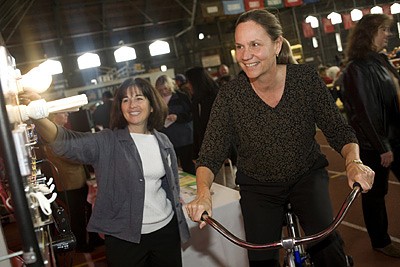Simple measures to freeze your runaway energy spending
By Sheri Hall
New Yorkers can save hundreds of dollars each year with simple measures to reduce their energy consumption, asserts a Cornell researcher who helped found the Consumer Education Program for Residential Energy Efficiency.
Joseph Laquatra hopes to see a national effort to educate consumers about energy use with an article in the December 2009 issue of the Journal of Extension that encourages states to use the program as a model.
Research shows that the average head of household doesn't know where to start, said Laquatra, professor of design and environmental analysis in Cornell's College of Human Ecology. "They think that if a house is built to code, that's all they need to worry about. But building codes only set a minimum level of energy efficiency. One of the goals of this program is to get people to think about energy efficiency in a different kind of way."
Since 2003 the program -- a collaboration between Cornell Cooperative Extension (CCE) and the New York State Energy Research and Development Authority -- has hosted more than 70,000 New Yorkers at energy conservation workshops and educated more than 9 million people visiting public exhibits.
Workshop participants cut their home energy bills by an average of $400, said Laquatra, and reduced their annual carbon dioxide emission by an average of 2.5 metric tons.
The program also awards mini-grants to county CCE offices to educate communities about energy use. In 2006, for example, extension educator Jerry Loch worked with officials at Fort Drum Military Base in Jefferson County, N.Y., to change 18,000 75-watt incandescent bulbs to 15-watt compact fluorescent bulbs. The change saved more than $200,000 and reduced carbon-dioxide emissions by 17 percent over a six-month period.
And in 2005 the program funded the purchase of two energy bikes to help demonstrate the energy use of such household items as light bulbs, a hair dryer, a fan and a small television, which are powered by the person pedaling the bicycle.
"The energy bike is a kid magnet at county fairs and schools," Laquatra said. "It helps demonstrate to families just how much energy it takes to power things they use every day, and it's been especially effective in showing the value of compact fluorescent light bulbs."
Laquatra recommends that the Consumer Education Program for Residential Energy Efficiency, which uses educators at local CCE offices to educate their communities, be leveraged nationwide.
"Extension educators know how to reach community leaders, so we have the multiplier effect of people teaching people," he said.
Research shows most U.S. households could reduce the amount of energy they use by two-thirds.
"There are 3,150 counties in the U.S., and cooperative extension educators reach all of them," he said. "So we have an army of educators that could help people make these improvements. We just need to provide the funding to undertake these initiatives.
"Without inventing anything new, people can make a tremendous difference," he said. "We just need to get them to think about energy efficiency in a different kind of way."
Sheri Hall is the assistant director of communications at the College of Human Ecology.
Media Contact
Get Cornell news delivered right to your inbox.
Subscribe